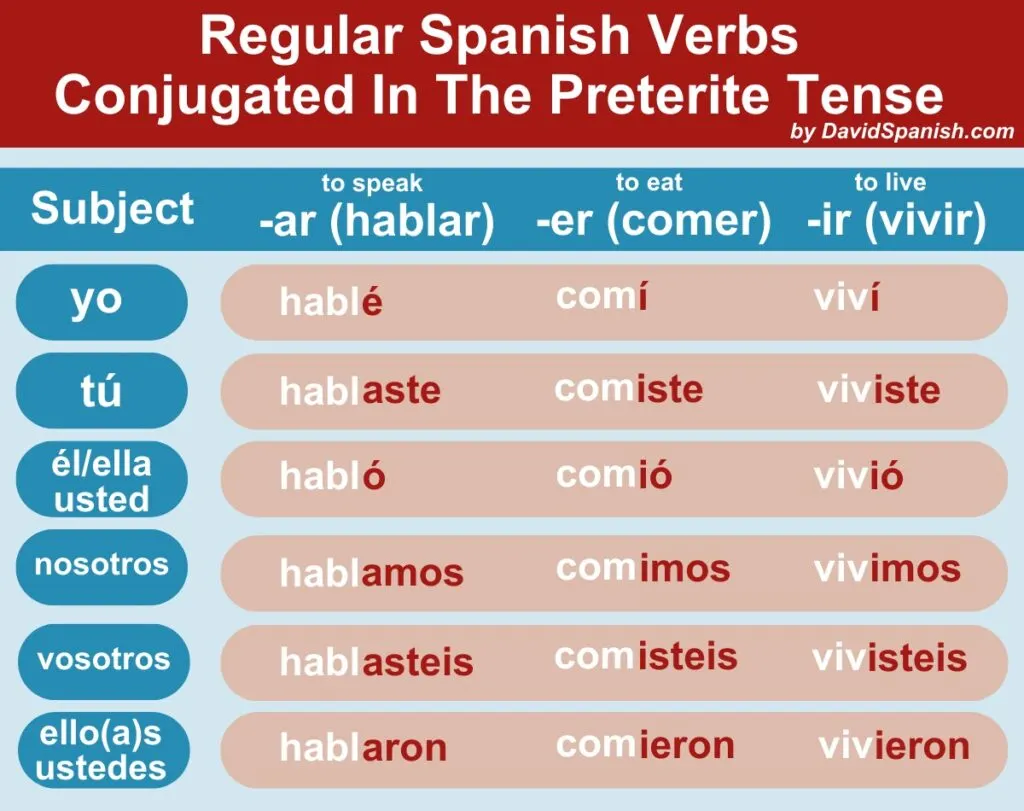Spanish Preterite Mastered

The Spanish preterite tense is a fundamental component of the Spanish language, used to describe completed actions in the past. Mastering this tense is essential for effective communication in Spanish, as it allows speakers to convey a sense of completion and finality regarding past events. The preterite tense is often contrasted with the imperfect tense, which is used for ongoing or repeated actions in the past. Understanding the differences between these two tenses and when to use them is crucial for expressing oneself accurately in Spanish.
Introduction to the Preterite Tense
The preterite tense, also known as the “pretérito perfecto simple” in Spanish, is used to talk about actions that started and finished in the past. It is a simple tense, meaning it is formed with a single verb, as opposed to compound tenses which require an auxiliary verb along with the past participle of the main verb. The preterite has distinct conjugations for each subject pronoun (yo, tú, él/ella/usted, nosotros/as, vosotros/as, ellos/as), and these conjugations vary depending on the verb’s ending (-ar, -er, -ir).
Regular Verbs in the Preterite
Regular verbs follow a predictable pattern when conjugated in the preterite tense. For -ar verbs, the endings are -é, -aste, -ó, -amos, -asteis, -aron. For -er and -ir verbs, the endings are -í, -iste, -ió, -imos, -isteis, -ieron. Here are a few examples:
- Hablar (to speak): hablé, hablaste, habló, hablamos, hablasteis, hablaron
- Comer (to eat): comí, comiste, comió, comimos, comisteis, comieron
- Vivir (to live): viví, viviste, vivió, vivimos, vivisteis, vivieron
Irregular Verbs in the Preterite
Unlike regular verbs, irregular verbs do not follow a predictable pattern when conjugated in the preterite. Their conjugations must be memorized individually. Common irregular verbs in the preterite include ser (to be), estar (to be), haber (to have), dar (to give), and decir (to say), among others. For instance, the verb “ir” (to go) becomes fui, fuiste, fue, fuimos, fuisteis, fueron in the preterite.
Using the Preterite in Context
The preterite is used to describe completed actions that have a specific beginning and end in the past. It is often used in combination with other tenses to provide a timeline of events. For example, “Ayer comí en un restaurante” (Yesterday, I ate at a restaurant) describes a completed action. When detailing a sequence of events, the preterite can be used to outline each event: “Me levanté a las siete, desayuné, y luego fui al trabajo” (I woke up at seven, had breakfast, and then went to work).
Contrast with the Imperfect Tense
The imperfect tense is used for actions that were ongoing or repeated in the past. Unlike the preterite, which focuses on the completion of an action, the imperfect tense highlights the action’s duration or repetition. The contrast between these two tenses is crucial for accurate storytelling in the past. For example, “Cuando era estudiante, estudiaba todos los días” (When I was a student, I studied every day) uses the imperfect to describe an ongoing past action, while “Aprobé el examen” (I passed the exam) uses the preterite to describe a completed action.
Conclusion
Mastering the Spanish preterite tense is a significant step towards fluency in the language. Understanding its correct usage, especially in contrast to the imperfect tense, allows for clearer and more precise communication about past events. With practice, learners can become proficient in using the preterite to describe completed actions in the past, opening up new possibilities for expression and interaction in Spanish.
How do I know when to use the preterite versus the imperfect tense?
+The choice between the preterite and the imperfect tense depends on whether the action is completed (preterite) or ongoing/repeated (imperfect) in the past. The preterite is used for actions that started and finished, while the imperfect is used for actions that were in progress or happened regularly over a period of time.
Are all verbs regular in the preterite tense?
+No, not all verbs are regular in the preterite tense. Regular verbs follow specific conjugation patterns based on their ending (-ar, -er, -ir), while irregular verbs have unique conjugations that must be memorized. Examples of irregular verbs include ser, estar, haber, and dar.
Can the preterite tense be used to describe future actions?
+No, the preterite tense is used to describe actions that occurred in the past. For actions that will occur in the future, Spanish uses the future tense or the present tense with a future time expression. For example, “Voy a estudiar” (I am going to study) or “Estudiaré” (I will study) are used for future actions.


